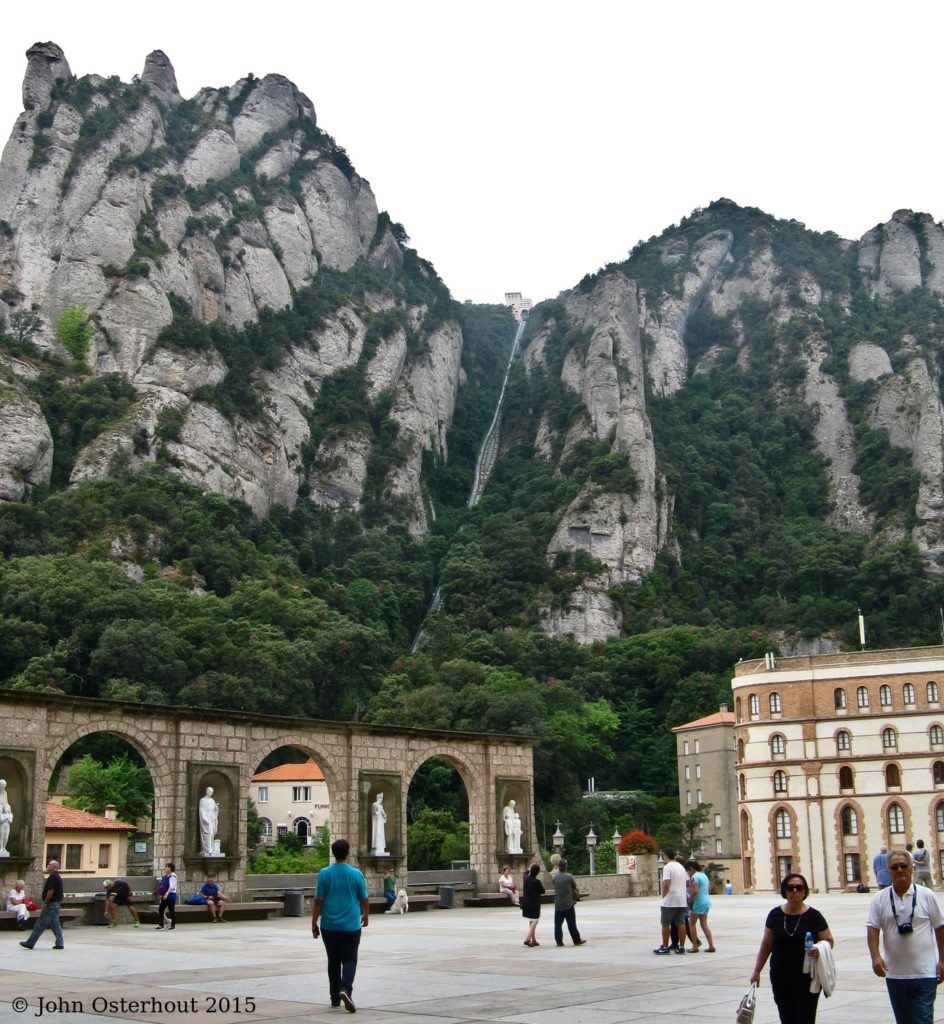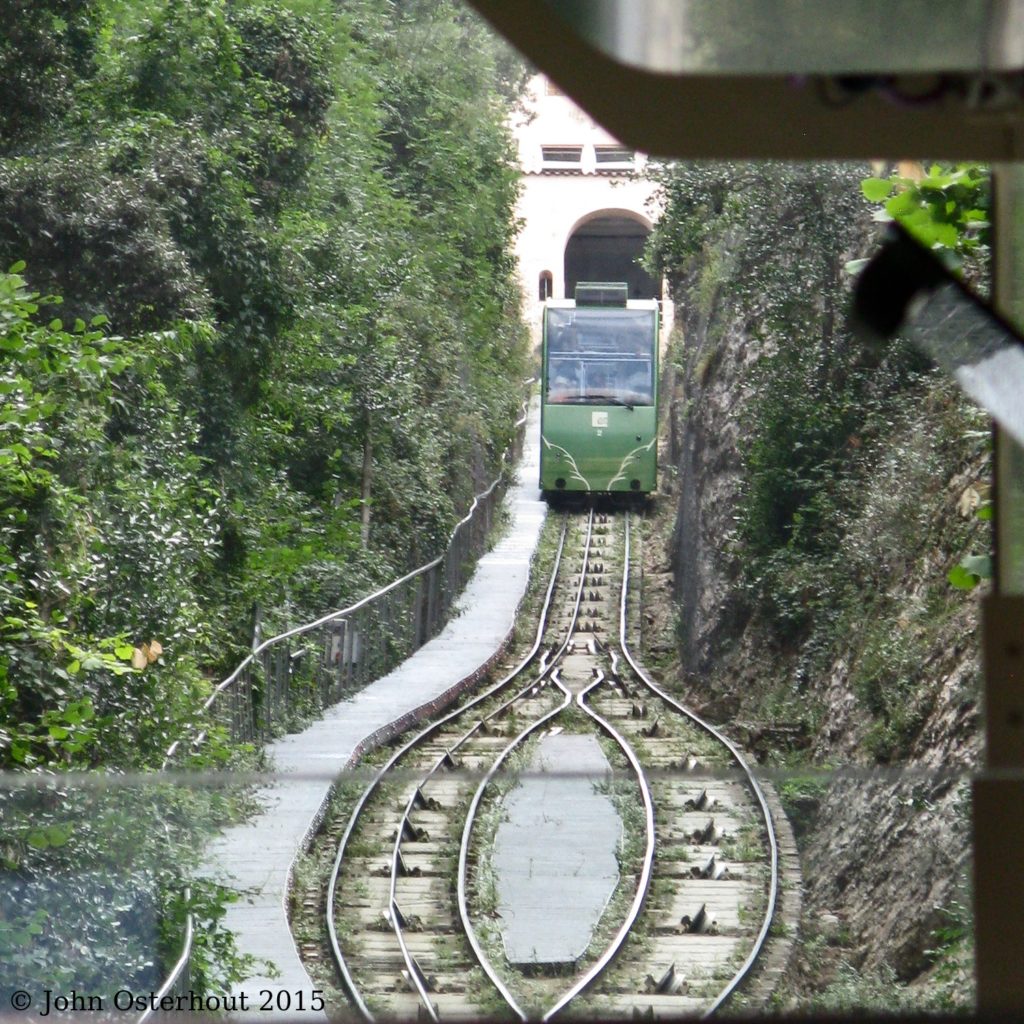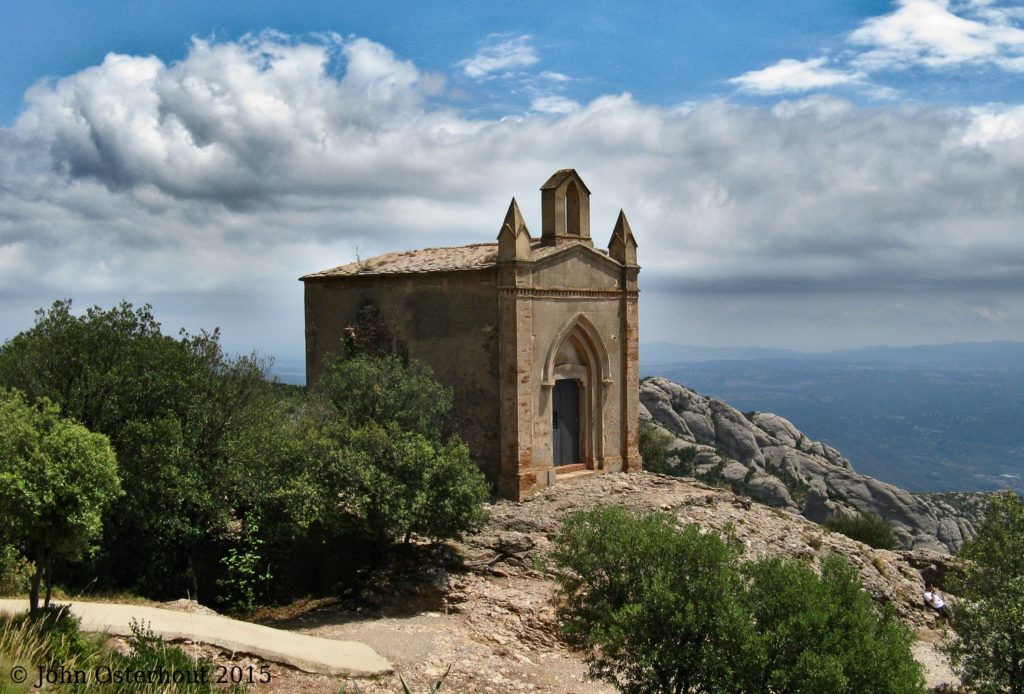Montserrat – saw mountain (serrated, like a handsaw). The mountain is home to the Benedictine abby, Santa Maria de Monserrat, which we visited in the summer of 2015 during our trip to Barcelona. Here are five frames.
Train, Train, and Another Train.

Our journey to Santa Maria de Monserrat started at the Placa Espana rail station, which was within walking distance of our hotel. Note that my previous post has photos of the Placa Espana and the Bullring, underneath which is the rail station. The R5 train towards Manresa will take you to the small town of Monistrol de Montserrat at the foot of the mountain. You can take the Rack Railway (Cremallera) or the cable car (Aeri) to the monastery. If you want to continue up the mountain you can hop on the funicular which is a kind of a cable car in which two cars are attached to the same cable and counterbalance each other as they go up and down the very steep slope of the mountain.
In the photo you can see buildings housing the rail termini: The Cremallara de Montserrat, which is a rack railway (also called a rack-and-pinion, cog, or cogwheel railway). The track has a rail in the center which engages a cog that allows the train to ascend grades up to 10%. On the left is the Funicular de Santa Cova, which goes down the mountain to the Santa Cova de Montserrat, the Holy Cave of Montserrat. It is in this cave that the Virgin of Montserrat was hidden during Moorish invasions. The Virgin de Montserrat was discovered by shepherds in the cave in 880. This lead to the founding of the Santa Maria de Montserrat Abbey. On the top right of the picture is the Funicular de Sant Joan which connects the monastery with sacred sites and walking trails further up the mountain.
Basilica of Montserrat

The construction of the basilica of Montserrat was begun in the 16th century. It was rebuilt in 1811 after the Peninsular War. A new facade was built between 1942 and 1968. The picture shows the interior of the basilica including the alter and the dome. The cross on the alter dates from the 15th century.
Funicular de Sant Joan

This is a shot from inside the monastery showing the track of the Funicular de Sant Joan going up the side of the mountain. Note that about 2/3 of the way up, the track splits so the up and down cars can pass. The maximum gradient on this funicular is 65%. Yikes!
Going Up!

This is the view from inside a car of the Funicular de Sant Joan. Our car is going up. Just a few seconds after this shot was taken, both cars jogged right and passed on the double track. It doesn’t look as steep as it is. When we got to the top, we had a nice hike before riding the funicular back down to the monastery.
Hermitage of Sant Benet

The hermitage was built in 1536 as a stopping point between the Hermitage of Santa Anna and the Hermitage of La Santisima Trinitat. This small chapel-shaped building was built later and is all that remains. This picture shows the Hermitage with a view from the mountainside.
Bonus Frame – Mare de Déu de Montserrat

This is the Madonna and Child statue venerated at the Santa Maria de Montserrat monastery. She and Sant Jordi (Saint George) are the patron saints of Catalonia. This statue is one the Black Madonnas of Europe. In Catalonia it is known familiarly as La Moreneta (the little dark one). It is thought to be a Romanesque sculpture from the 12th century, although the legend of the Santa Cova indicates that the statue was discovered in 880. No o photography was allowed when we visited so I offer a picture from wikipedia.
Attribution of the La Moreneta picture: By Misburg3014 – Own work, CC BY-SA 3.0, https://commons.wikimedia.org/w/index.php?curid=22225943
With the exception of the La Moreneta image, these photos were taken with a Canon PowerShot A720 IS. They were processed with Darktable a free program available for Windoze, Mac, and Linux.
Looks like you are going from a photo blog to a travel photo blog. Good work.
I had a real quandary with the Barcelona/Montserrat Posts. I had a lot more material, but the photos are constrained by my other pursuits. I’ve never set out to use photography to characterize a city. However, I’m beginning to think that perhaps I should go for expanded posts about the cities I visit since a lot of my photography when I travel is for memories. I do hidden art and street photography, too, but I’ve got more “travel photos”. So do I try to do some “travel posts” or do I just throw up some photos from the various cities and call it a day?